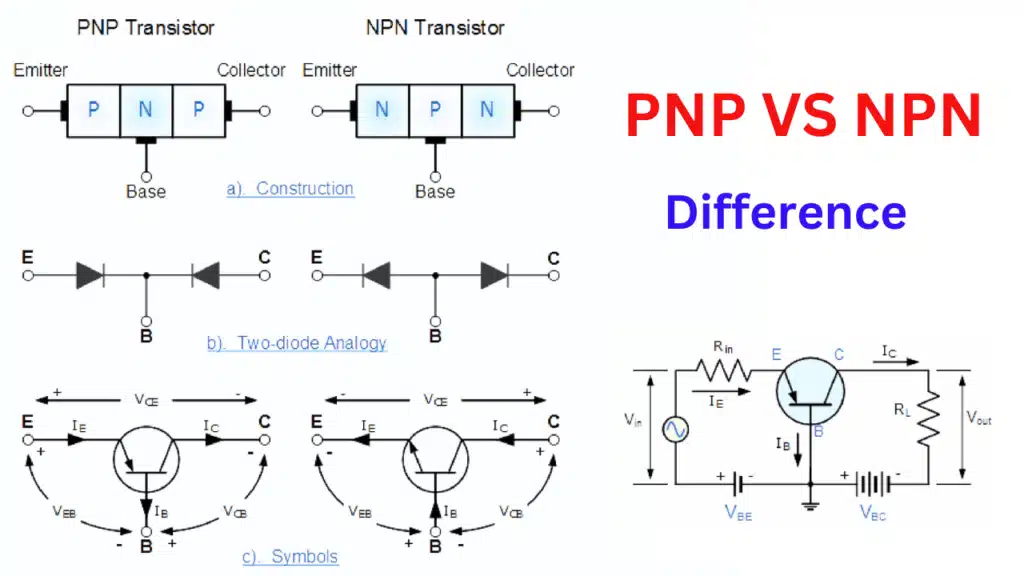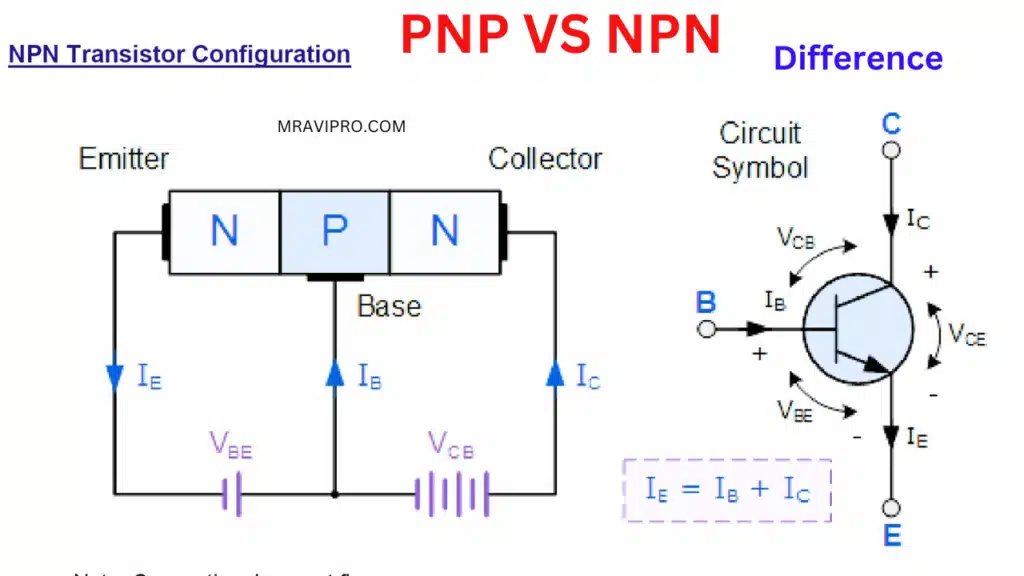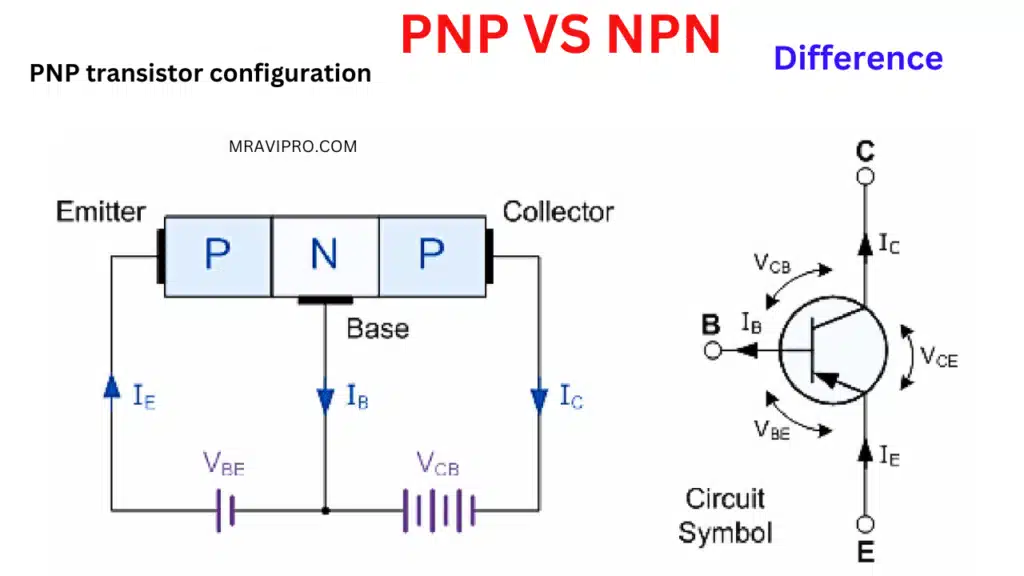Bipolar junction transistors (BJTs) come in two main polarity varieties: PNP transistors and NPN transistors. A three-layer semiconductor BJT is a signal amplifier for electrical signals. The placement of the semiconductor layers in the two different types of transistors results in different behaviors and uses.

PNP vs NPN Transistor Fabrication
Both PNP and NPN transistors consist of three layers: an emitter, a base, and a collector. However, the arrangement of these layers is different for each type.
PNP Transistor
In a PNP transistor, the emitter is made of a P-type semiconductor, while the base and collector are made of N-type semiconductors. The layers are arranged in P-N-P
NPN Transistor
On the other hand, an NPN transistor has an N-type semiconductor for the emitter and P-type semiconductors for the base and collector. The layers are arranged in the order N-P-N.

How do PNP VS NPN transistors work?
The movement of charge carriers—either electrons or holes—across the various layers underlies the operation of PNP and NPN transistors. Let’s investigate how each type functions:
PNP Transistor Operation
- Forward Biasing: When a positive voltage is applied to the base with respect to the emitter, the base-emitter junction becomes forward-biased. This allows holes from the base to flow into the emitter region.
- Emitter Current: As a result of forward biasing, a current of holes flows from the base to the emitter. This current is called the emitter current (Ie).
- Base Current: Some of the holes from the base combine with electrons in the base region, generating a base current (Ib). The base current controls the flow of current between the collector and emitter.
- Collector Current: Due to the flow of base current, a larger current of electrons flows from the collector to the emitter. This current is called the collector current (Ic) and is significantly larger than the base current.
NPN Transistor Operation
- Reverse Biasing: In an NPN transistor, a positive voltage applied to the base with respect to the emitter reverse biases the base-emitter junction, allowing electrons to flow from the base to the emitter region.
- Emitter Current: The flow of electrons from the base to the emitter constitutes the emitter current (Ie).
- Base Current: As a result of reverse biasing, some electrons combine with holes in the base region, creating a base current (Ib). The magnitude of the base current determines the flow of current between the collector and emitter.
- Collector Current: The base current controls a larger current of electrons flowing from the collector to the emitter, which is the collector current (Ic).
Applications of PNP VS NPN Transistors
Many electronic circuits use PNP and NPN transistors because of their unique properties.
PNP Transistor Applications
- Amplification: PNP transistors are commonly used for amplifying weak signals in audio and radio-frequency (RF) circuits.
- High-Side Switching: PNP transistors are suitable for high-side switching applications, where the load is connected between the collector and the positive supply voltage.
- Voltage Regulators: PNP transistors are used in voltage regulators to stabilize voltage levels.
NPN Transistor Applications
- Amplification: NPN transistors are widely used for signal amplification in electronic devices.
- Low-Side Switching: NPN transistors are suitable for low-side switching applications, where the load is connected between the collector and the ground.
- Digital Logic: NPN transistors are crucial components in digital logic circuits, acting as switches to control the flow of current.

Advantages of PNP and NPN Transistors
Depending on its unique properties, each type of transistor has unique advantages.
Advantages of PNP Transistors
- Higher Current Capability: PNP transistors have higher current-carrying capabilities, making them suitable for high-power applications.
- Lower Base Current: PNP transistors generally require less base current to achieve a given level of collector current.
- Easier High-Side Switching: PNP transistors are easier to use in high-side switching configurations.
Advantages of NPN Transistors
- More Common: NPN transistors are more commonly available and widely used in various electronic circuits.
- Lower Cost: NPN transistors are often more cost-effective due to their higher demand and production volumes.
- Better Performance in Digital Circuits: NPN transistors perform better in digital circuits, providing efficient switching capabilities.
PNP VS NPN Transistor :
A comparison chart highlighting the variations between PNP and NPN transistors is provided below:
| Characteristic | PNP Transistor | NPN Transistor |
|---|---|---|
| Emitter Semiconductor | P-type | N-type |
| Base Semiconductor | N-type | P-type |
| Collector Semiconductor | N-type | P-type |
| Current Flow | Hole | Electron |
| Amplification Direction | Negative | Positive |
| Common Applications | Audio amplifiers, voltage regulators, and high-side switching | Signal amplifiers, digital logic circuits, and low-side switching |
| Current-Carrying Ability | High | Moderate |
| Base Current Requirement | Lower | Higher |
- Also, Read This article: How Long Does a Car Battery Last
- Also, Read This Article: 4s Lipo Battery Full Details and Problem Solution
- Also, Read This Article: 12V 7Ah Battery Charger Circuit Diagram
- Also, Read This Article: 3.7Volt Li-ion Battery Charger Full Details & Solution.
Conclusion
In conclusion, PNP VS NPN Transistors, each with specific properties and uses, are crucial parts of electronics. While NPN transistors are widely employed in signal amplifiers and digital logic circuits, PNP transistors are frequently used in high-power applications. The ability to effectively design and construct circuits is given to electronics hobbyists by understanding the distinctions between these two types of transistors.
FAQ
Are PNP and NPN transistors interchangeable?
No, because of their distinct polarities, PNP VS NPN Transistor cannot be utilized interchangeably in electronic circuits.
Which transistor type is better for high-power applications?
Because they can handle more current, PNP transistors are better suited for high-power applications.
Can NPN transistors be used for low-side switching?
True, low-side switching applications frequently use NPN transistors.
What are the main differences between PNP VS NPN transistors?
Their semiconductor layer configuration, current flow, and amplification direction primarily distinguish them from one another.
What are some common applications of NPN transistors?
NPN transistors find applications in signal amplifiers, digital logic circuits, and low-side switching configurations.